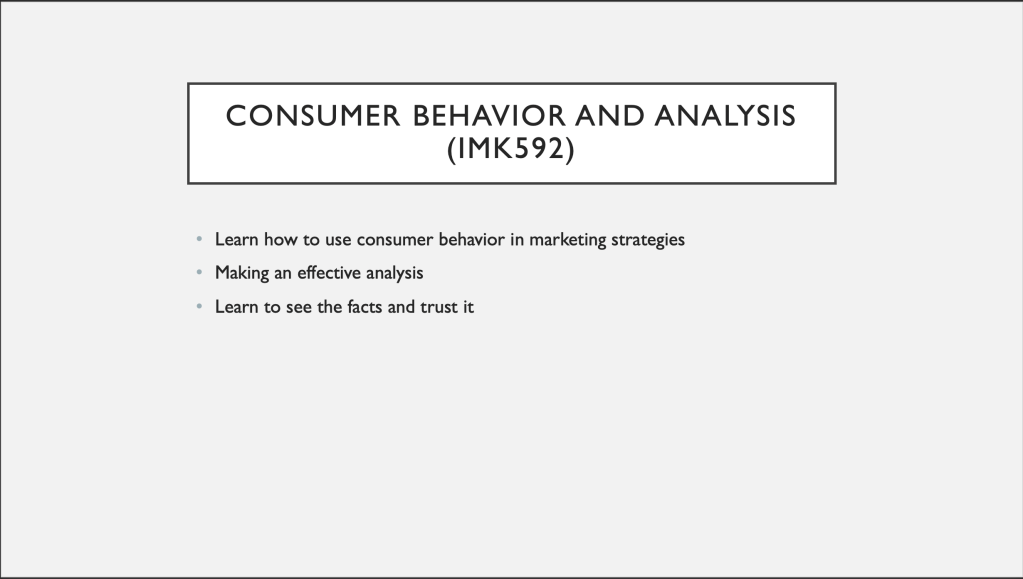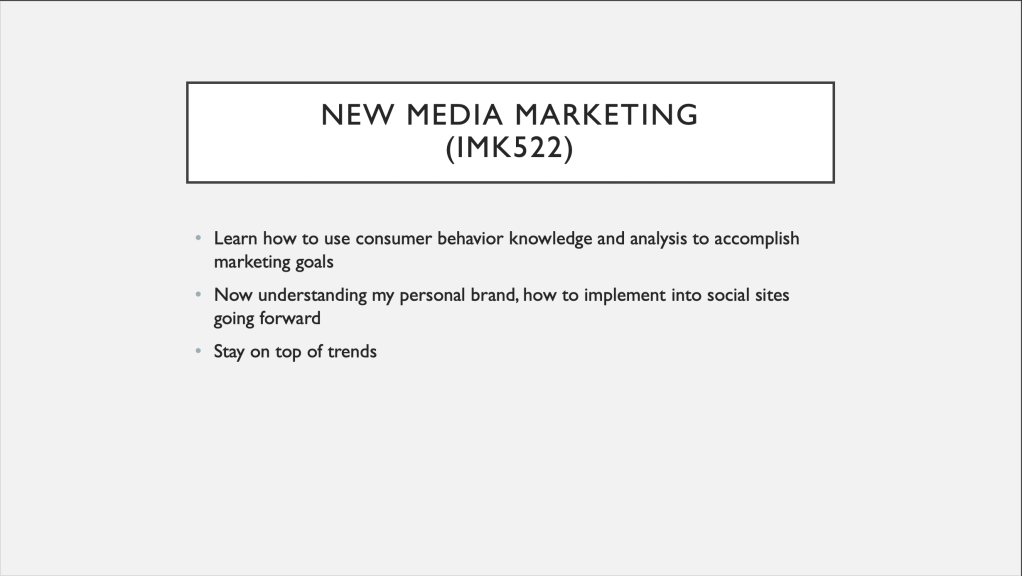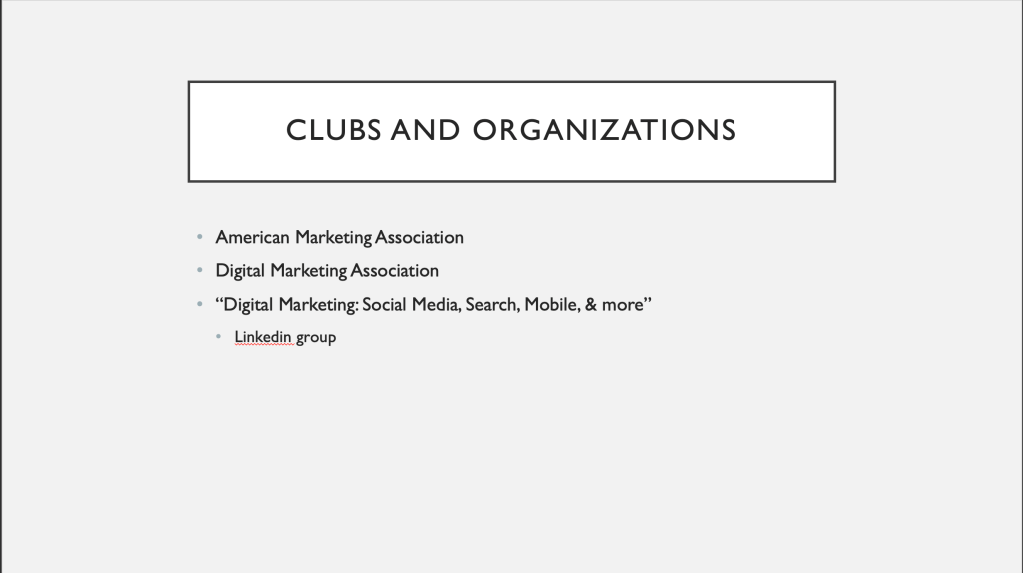
Digital Marketing Fundamentals
For this post, you want to consider how this course met your original objective, what you learned from the course content, and how you will apply it professionally.
Assignment Instructions
Reflecting on my second course, Digital Marketing Fundamentals, I believe everything I thought I would learn was right; however, I did learn way more. Going into this course, I knew that a fair amount of time was spent on every aspect of marketing. Still, I underestimated just how much time is needed at every step in order to produce a quality marketing strategy.
The most exciting thing I learned from this course, Digital Marketing Fundamentals, is Search Engine Marketing (SEO) tools, the quantity, and the importance of them. Digging deeper into the ins and outs of digital marketing only made me that much more excited to go even further into the program and to understand better how to utilize other digital marketing tools and how to implement them into a marketing strategy best.
Outside of the topics in the course, I also underestimated just how much time should be dedicated to each week of course work. This first course was an excellent way for me to catch on to the speed of how things will go, although I was told it only gets faster from here.
Going forward, I plan on tightening up my schedule that much more. Add in even more time to read more into each of the weekly topics to benefit my assignments and projects. I also want to learn a lot more about other digital marketing tools so I can create a better platform for my brand as I head into my professional career. My goal is to rebrand my social feeds to reflect myself better.
DIGITAL STORYTELLING AND BRANDING
Consider how this course met your original objective, what you learned from the course content, and how you will apply it professionally.
Assignment Instructions
This course met all my original objectives, to understand how to define a brand’s voice, implement my brand into job searching, and be a captivating storyteller. Building a strong brand is the key to success.
Week one was about not only our company’s brand but our brand as well. Assignments such as writing a Personal Branding Statement assisted in reflecting on who I am as a professional and how I can better shape my brand.
In week two, “differentiation and brand voice,” we analyzed how brands like Target differentiates itself from its competitors, such as the environment in Target, its cleanliness, well-lit stores, and organization. As well as, learned a method to assist in establishing the brand voice by brainstorming words associated with a character or actor with the same traits then using that character as a representation of the brand’s voice.
In week three, “Archetypes,” or brand personality, using the archetype quiz from kayeputnam.com, we can see a breakdown of our brand personality and how it translates to customers. This was very helpful, digging deeper into the emotion that customers feel towards their brands of choice as well as how to reach them.
Week four, “Customer Brand Experience,” now understanding what the brand is, the personality, and the voice, it is vital to implement throughout, on, and offline. Starbucks was the perfect company to study for this week’s discussion assignment. Their brand image remains positive in their customers’ minds due to customer service in-store and online, as well as rolling out new ideas constantly. With this course’s help, I now know the right questions to ask when considering a brand story, voice, and personality and how to implement it throughout a company. I also better understand that a brand is not always what you (the company) think it is, but it is what the audience feels about you, and once the audience is understood, growth as a company can follow.
Consumer Behavior and Analysis
Consider how this course met your original objective, what you learned from the course content, and how you will apply it professionally.
Assignment Instructions
This course exceeded my original goals, to learn how to use consumer behavior in marketing strategies, making a useful analysis, and learn to see the facts and trust it. Going into this course, I knew what I would learn would be vital; however, I did not understand how deep one can take consumer analysis.
During the first week, we discussed the buyer’s journey or the consumer decision-making process. It starts with the buyer persona, a character that represents the company’s typical customer, lifestyle, demographics, and preferences. Establishing a persona is key to reaching customers, by better understanding, the customer helps share relevant content and thus creating more traffic for the company. We also discussed the three primary categories of consumer information, demographics, psychographics, and internet consumer behavior. Each group helps define the characteristics of a company’s consumer; that way, the company’s ads reflect their interests. Learning this, I now understand what I was missing in my path to this industry; this area of digital marketing was something I always strive to be better. This course served vital information; I do not think I would have been able to gather on my own.
Week two focused on consumer segmentation, taking the three primary categories of consumer information, demographics, psychographics, and internet consumer behavior, then further breaking them into smaller segments. Again, a way to also understand the company’s customers to gear the marketing towards them. Demographic segments break down to age, gender, and family size. For example, my company’s target demographic is married women between the ages of 22-54. Psychographic segments are the customer’s activities, interests, and opinions. This can assist in understanding why consumers act the way they do. Finally, behavior, such as benefits sought, usage rate, and the readiness to buy, is the behavior towards the products.
During week three, we learned the importance of Consumer-Generated Marketing or Consumer-Generated Content, utilizing this helps drive traffic and sales. Allowing the customer to provide feedback while adding fun incentives for ad content is a powerful tool that helps make a company visible. In the age of social networks, people often refer to reviews online before purchase to learn more about a product and how it differs from other companies.
Finally, week four, online consumer surveys and the benefits of knowing consumer’s responses, this week’s focus was creating a sufficient email to follow up with after a consumer makes a purchase. We examine each component’s importance, making up a follow-up survey email to be attention-grabbing but brief to keep their attention. Equally as important, we touched on the CAN-SPAM Act and its main requirements and penalties. This information was surprising to learn, curious about this act going forward. I’ll be anxious to know how others feel about this in the industry.
New Media Marketing
You want to consider how this course met your original objective, what you learned from the course content, and how you will apply it professionally.
Assignment Instructions
Throughout this course, we learned the importance of differences between the customer, the fan, and the influencer. How to hone in on their interests, what they do online, and how to reach them most successfully. We went over the keys of using our personas to assist in researching who would match up best regarding our influencer or ambassador. Additionally, we discussed influencer and ambassador programs and how they can play a crucial role in a brand’s success by sparking conversation and spreading positivity about it. Shockingly, I discovered that my target audience is on sites like Pinterest more than places like Instagram or Twitter. We discussed the type of client that best suits the ambassador’s role and what makes a successful ambassador program. We went over the importance of the approach regarding negative comments and social media etiquette for brands – which for my brand is very important because we just recently had one of our doctors comment back to clients on Facebook on behalf of the clinic – with an approach of “I’m right, and you’re wrong.”
Going forward, I am excited to use what this course provided in my current job as a content manager. We are continually looking for more engagement, and this course assists in building engagement and researching the audience to better gear our content for our audience.
Advanced Digital Marketing Strategies
You want to consider how this course met your original objective, what you learned from the course content, and how you will apply it professionally.
Assignment Instructions
Throughout Advanced Digital Marketing Strategies, We discussed how to reach the brand’s audience throughout each AIDAS model stage. The importance of understanding a brand’s audience, their interests, and how to use it to better the overall marketing plan.
Week two covered landing page optimization, how to best optimize a path to get customers to convert and establish trust at the beginning of the relationship with the audience, starting with the page they land on.
Week three, driving traffic to a brand’s site, set goals for conversions and revenue, and used metrics to assist in campaigns. I had the most difficult time this week because my company does not have any numbers to go off of because the clinic is too small.
Week four, adding it all together into one project was the easiest part considering we did most of the work in the weeks prior. The most challenging part was making the numbers make sense due to incomplete statistics, keywords, audience demographics, geography, etc. However, I felt the most accomplished this week due to a better understanding of what was being put together.
STRATEGIC INTERNET PUBLIC RELATIONS
You want to consider how this course met your original objective, what you learned from the course content, and how you will apply it professionally.
Assignment Instructions
In class, we discussed the foundations of Public Relations, the slippery slope of ethics, and the importance of monitoring brands before, during, and after a crisis. My case study company not only does not monitor their brand mentions, reviews, or online presence nearly as much as they should. Far worse, when one does happen upon the negative comments and reviews, even if it is months or, I’m afraid, even YEARS later, the owner takes it upon himself to respond to the user who posted it. It’s quite an awkward exchange.
Public Relation goals, implementing tactics to reach the set goals, measuring the progress; The goal in PR is to change perceptions and attitudes, acting as a lighthouse of communication for a brand. In this course, we discussed what makes up an official press release and the preparation that goes into press releases. I know it’s essential always to have a press release ready, but in some situations, having a press release written out to the point where you simply fill in the blanks is weird to me. The thought of efficiency is so vital that the response is almost robotic, but I suppose it would not appear that way if it’s a well-written release.
Equally as necessary is the distribution plan, which I learned the most – it was interesting to learn about News Wires and behind the scenes of a press release. Putting together a crisis communication plan was by far the most stressful thing I’ve done, and I cannot imagine what that would be like sped up in real-time, although I would have a team working alongside me. Lastly, going back to having a press release ready, I grew a better understanding of its importance as I was working on the crisis communication assignment.
DIGITAL MARKETING AND THE LAW
What were your three original objectives for this class?
Assignment Instructions
Did the class meet those objectives?
What did you learn from the class?
How can you apply the information you learned in class to your professional career?
I suppose the overall goal of any course is to continue learning how to be a better marketer and use the tools in the course in a marketing campaign, building a brand, or even personal projects in the future. In this course that included learning more about privacy online and laws regarding email, I learned more about the cases resulting in the creation of laws. The class met the objectives and then some; it was almost overwhelmingly so.
Throughout this course, I learned the definition of Spam, Copyright, Defamation, and Jurisdiction and how those fold into marketing. More specifically, how the CAN-SPAM Act sets guidelines, protects marketers, and how the first amendment, specifically, freedom of speech, comes into play regarding Spam. The ins and outs of Copyright and how to use it to navigate projects, how to protect intellectual property, and the limits of protection. Lastly, with defamation, we touched on the differences between slander and libel, ways to define it, ways to defend it, and how social media sites can be a platform for defamation. Jurisdiction was the most challenging week because the internet obviously has no jurisdiction. After all, it is not tangible, but we went into depth about what defines the jurisdiction of a crime online, that it is not as simple as the location of the user, but where the user is targeting their information. This course was incredibly essential to my professional career because legal aspects of marketing are valuable at every step, from design to campaign implementation.
Digital Marketing Campaign Development
Consider how this masters program met your original objective, what you learned from the program content, and how you will apply it professionally.
Assignment Instructions
This master’s program exceeded my original objectives of developing an effective marketing campaign from top to bottom. Using the brand elements to enhance a brand’s message, creating a brand story is an essential piece of the brand voice and the tone you set in messages sent to customers in person, on, and offline. Also crucial in the messaging to send out is the consumers’ interests, how it plays a role in their decision-making, and the steps in their process as they’re making a purchase—using their decision-making gear advertising and messaging to reach the audience at the perfect moment to receive the most conversions or reach the particular goal set for that campaign.
The most challenging portion of the program was understanding SEO, website optimization, and the laws regarding a company’s website. Making changes to a website for it to be crawled and increase web ranking was challenging due to my business being in an industry that does not mainly take part in anything digital unless it is part of a corporate business. Brands enforce privacy agreements, terms of service, and the CAN-SPAM act to protect a brand and its website transactions. Jurisdiction was also a challenging topic because the internet has no jurisdiction. After all, it is not tangible, but what defines the jurisdiction of a crime online is that it is not as simple as the user’s location but where the user is targeting their information. Although my case study company did not need to worry about jurisdiction specifically, I found it more critical for me personally.
Lastly, the program’s final course emphasizes bringing all of the elements in a campaign together, exceeding my thoughts from the beginning of the master’s program. It is easy to have the “great idea” and have it formed into the brand’s style and voice, but it is never as simple as what you as the marketer thinks will work or what you like personally. The devil is in the details, and unless there is proof that your audience will appreciate it as much as you do, it is a waste of time.

















